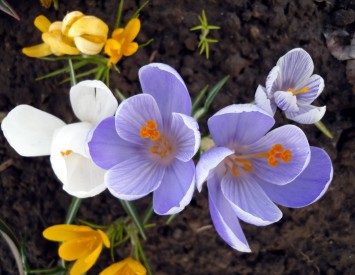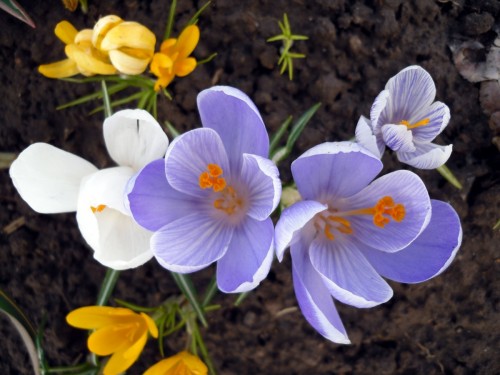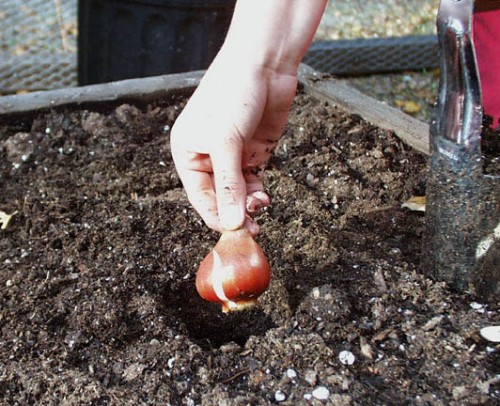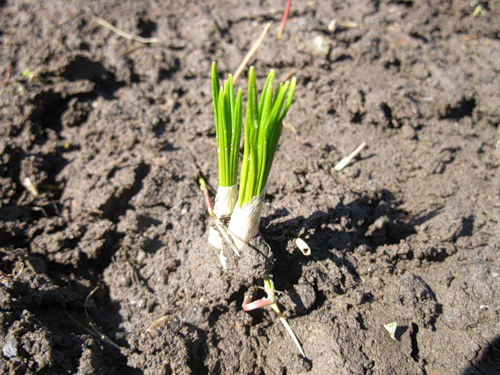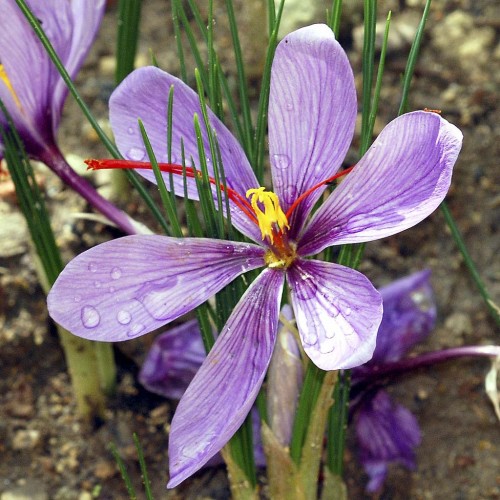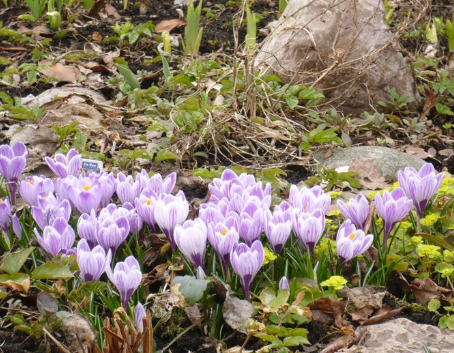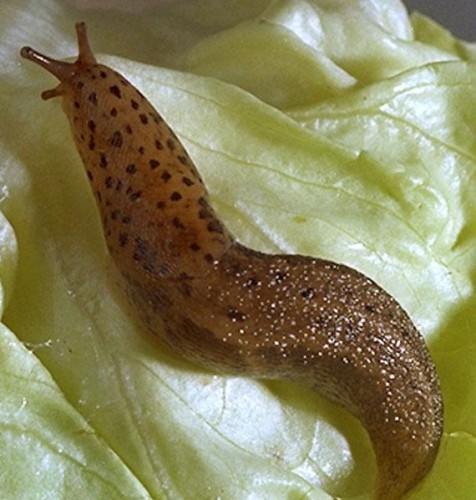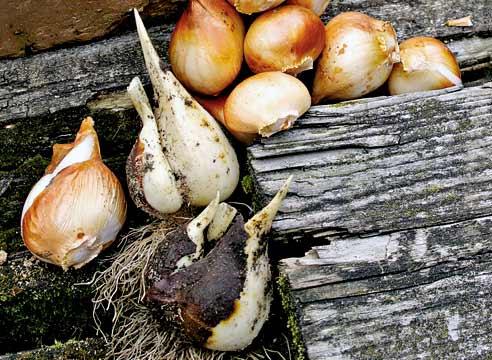Small beautiful crocuses, as a symbol of awakening from winter hibernation, rather unpretentious plants. Properly planted, with a minimum of care, they will break through the snow for many years in a row. They do not interfere with other plants, as they bloom before all, so crocuses will be appropriate on any lawn.
Types of crocus
There are two types of crocuses that grow in gardens and lawns:
- Botanical, which, in turn, are divided into spring and autumn. Among the spring crocuses, the most popular are golden flowers and Tommazini, which has pink or purple, a funnel -shaped slightly elongated shape with bright yellow stamens. Golden flowers are known for their lush flowering. On one corm can be up to ten flowers. The petals in such flowers are darker, the color is blue-violet.
- Hybrid or Dutch crocuses differ in large flowers with a very extensive gamut of colors, there are crocuses of both monophonic and two -color. It is these crocuses that are like to put in the photo those who sell bulbs, because they immediately attract attention with their size and beauty.
Both of these types have a variety of coloring, you can often find white, yellow and all shades of purple crocuses.
Planting flowers
In order for the crocuses to feel well on the lawn, they need to choose such a place for planting, which is warmed up by the sun on the one hand, and on the other, it is a little in the shadow of branches of trees. The soil for this plant should be well drained.
It is necessary to plant bulbs of crocus in the ground in the fall, one and a half to two months before the onset of frosts. You need to focus on the temperature of the soil, it should be more than 15 degrees at night. The most suitable months is September and the beginning of October, in the southern regions of Russia you can plant in November. They plant crocks tubers, adhering to such rules:
- Loosen the soil with a shovel or cultivator. The depth of loosening should be about 20 cm.
- Swing a compost on top of the ground, a layer of 5 cm, and mix.
- Take the most healthy good tubers for planting.
- Put onions in a solution of potassium permanganate to protect them from fungal diseases.
- Dry the pits 10 cm deep and plant tubers in them, with a sharp end up. Put it up to the ground and press it well to the bulb.
- You can plant either evenly from each other one at a time, at a distance of 4 cm, or in heaps of 10 flowers, so the effect of flowering will be brighter in the spring.
- Planted bulbs need to be watered.
If there are a mice on your lawn, then it is necessary to plant crocuses in cups made in the form of a wire grid. Otherwise, mice can simply gnaw unprotected flower tubers.
Since crocuses are flowers that multiply remarkably, it is enough to plant about 20 pieces at a time, and the next year there will be much more.
Crokus care
Crocuses - flowers are unpretentious and do not require special care, how almost every novice gardener knows how to care. The main thing for them is to be:
- Weeding.
- Loosening.
- Watering.
- Top dressing.
Crocuses are fed about a month after planting. To do this, use 50 grams of calcium nitrate per square meter of soil. Six months later, that is, in the spring, the plants need to be fed again. To do this, you can take the same fertilizer or not calcium, but potassium or ammonia nitrate. Some gardeners use urea to feed the plant in early spring, but experts say that this is a useless fertilizer, because at this time of year the plants do not absorb nitrogen.
In the second top dressing, the plant needs until the growing season begins, and for the third time after the Crocus foams. In mid -May, you need to feed the plant with phosphorus fertilizer, no more than 40 grams per m 2 .
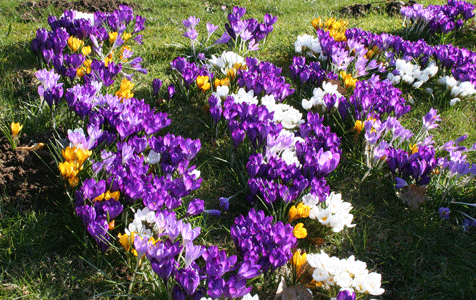
As for humidity, any flower grinder knows that it is better to let the crocus a little not enough than an excess. The plants, although they will not die, but they will not bloom as magnificent as usual. Therefore, if the winter was snowy, then the crocus will be enough moisture in the ground and they do not need to water them completely until the hot, arid weather is installed. Typically, crocuses are watered once a week, about 30 liters per m 2 To get the earth well well.
It is necessary to continue to water crocuses in the summer, when they already bloom, in order to keep the tubers during the drought. In the winter, with cold climate, crocuses can be covered with a layer of mulch by five centimeters, so the humidity will remain. On the lawns it is not recommended to mow grass until the stems of flowers are dried.
You can spend weekly on crocuses with stimulants of growth, while you can save a fourth part of the fertilizers. Among the stimulants are the most popular:
- Heteroauxin.
- Zircon.
- Epin-Exfrast.
After their use, crocuses will bloom and it is better to multiply.
Storage of bulbs
When the leaves of the crocus turn yellow and dry a little, the most favorable time will come for their digging, because later it will be impossible to find them in the grass. And if you dig without seeing exactly where the tuber grows, you can damage it. After you dig tubers from the ground, do such manipulations with them:
- Sort through the tubers: whole and good in one string, defective - in a garbage bucket. Do this without unnecessary pity, the defective will still not grow, only spend time on them.
- Free healthy bulbs from the ground and remove the dead scales.
- If there are some small damage, then you can anoint them with green or sprinkle with earth.
- Put the balls for a week in the shade, let them dry.
- Sort the bulbs in size and put in boxes with holes for air ventilation. The room should be well ventilated and not hot. There, tubers will be stored until September, when it comes to plant them in the ground.
Bulbs are dug for various reasons:
- To transplant to a new place.
- To remove unhealthy plants.
- To treat the lawn with copper sulfate and fertilize.
- To divide the nests and thereby prevent density. Because with intensive division in the future, plants will only interfere with each other to grow normally.
- To sell tubers.
Diseases of crocuses
If you plant healthy bulbs of crocuses, then many diseases can be avoided when growing. For planting, you need to choose bulbs that are firmly to the touch, have no stains of rot and have not yet sprouted. But still, there are enemies of such a plant resistant to diseases:
- Wireworms are the larvae of beetles, their activity can be seen in the form of holes on the tubers. They live for about four years and there are especially many of them in early May. During this period, it is necessary to make small recesses in the soil and put in them rushed grass or hay, and cover with boards on top. If you had wireworms on the lawn, they will quickly crawl into these holes and will remain there and there, because it is the most fertile environment for them. To get rid of these larvae, you need to burn this grass and repeat the procedure several times.
- Slugs are lovers of ground cover plants, if your crocuses grow near thyme or phloxes, then the attack of slugs can befall them. There is only one method - to remove slugs from plants.
- Viruses - they can be recognized on a crocus thanks to deformed flowers that cannot completely open. Also on the leaves there are grayish spots. The carriers of the disease are aphids and mice. So that the virus does not spread throughout the lawn, you need to gently dig the plant and throw it away. This must be done as soon as a sick plant is noticed, since the virus spreads very quickly. If you are not sure of the diagnosis, plant this plant separately and observe, it happens that Crocus heals itself in a few years.
- The fungus - if the crocuses were planted in late autumn, they do not have time to let out large and powerful roots. And they are overcome by fungi. In the spring, such plants look weak and painful, their tubers become soft and begin to rot. Such plants need to be urgently digging and destroyed. The risk of fungal diseases in raw and warm weather increases several times. To avoid this disease, you need to carefully inspect the tubers with the planting, if there are molds or a dispute from mushrooms. When you plant new crocus tubers, when landing, retreat a little from the existing plantations so as not to accidentally infect flowers. If such tubers are found, then sprinkle them with ash and leave to dry for a week. It is also not recommended to grow crocuses for many years in a row in the same place.
Pest combat measures:
- Do not plant flowers next to the non -cultivated area.
- In winter, you need to cover the crocuses with branches of a spruce spruce.
- When planting, use special plastic baskets that are designed to protect against pests.
- After planting the bulbs, tamp the soil.
- On the lawn, you can put turntables and reputers with ultrasound.
- The entire supply of tubers does not need to be planted nearby, it is better to divide them into how much parts and plant throughout the lawn.
